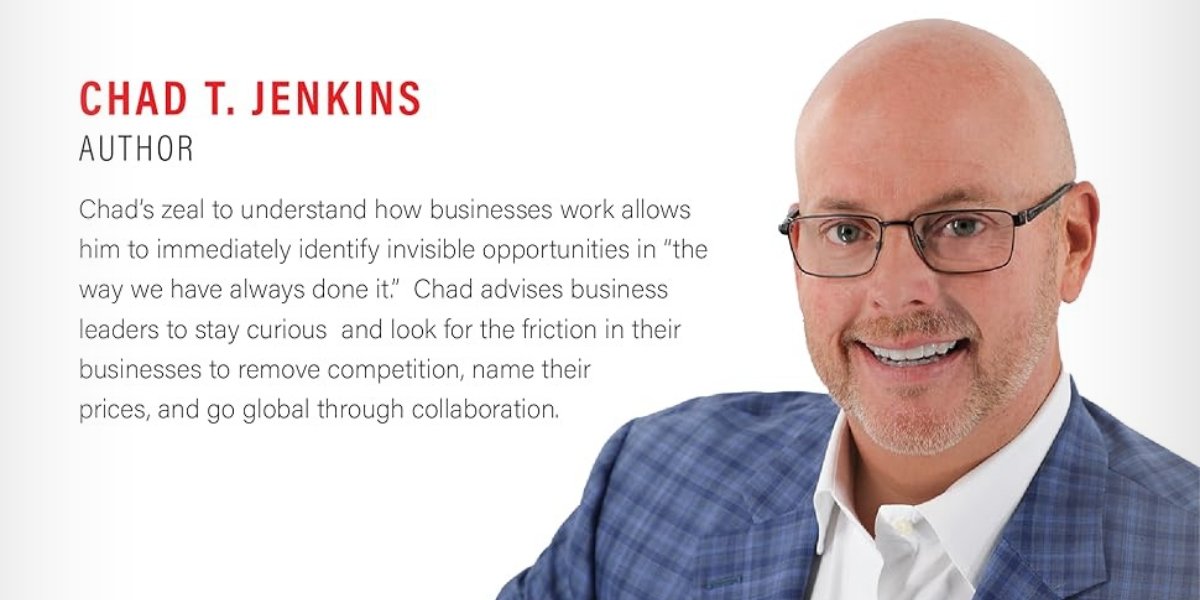Chad T. Jenkins on Adding Zeros, Ditching Competition, and Building a “Category of One”
By: Elliot Harper
Other good replacements could be: bold, groundbreaking, revolutionary, or game-changing — depending on how strong you want the impact to feel.
It’s the central message of his book Just Add a Zero: Remove the Film, Outperform Your Competition, and Grow Exponentially through Collaboration. Drawing from decades of experience, Jenkins offers a framework that flips conventional growth strategies on their head. Instead of clawing your way to the top by yourself, Jenkins argues, the fastest route to exponential success lies in partnering with others who have what you lack—and who need what you have.
Recently, I sat down with Jenkins to dig into his ideas, his signature “VCR Formula,” and the bold vision driving his work.
Adding a Zero Where It Matters Most
When asked what area of his life he’d “add a zero” to—a metaphor from his book for multiplying impact—Jenkins didn’t choose money, health, or even time. His answer was Reach.
“Adding a zero to Reach amplifies everything else,” he explains. “With the right connections, new capabilities emerge, and bold visions scale faster.”
In his view, a tenfold increase in Reach would fuel his mission to accelerate the global shift from competition to collaboration. This isn’t just about networking—it’s about what he calls “Collaboration Currency™,” the collective value unlocked when the right people, ideas, and resources collide.
Collaboration Over Competition
Jenkins’s belief that collaboration now outperforms competition in today’s marketplace isn’t just theoretical. He points to Kylie Jenner’s meteoric rise in the cosmetics industry as a textbook example.
“She had the Reach and Vision, but she didn’t build a factory or R&D team,” Jenkins says. “Instead, she partnered with a friend of her father who owned a top-tier cosmetic manufacturing facility—the Capability.”
That strategic partnership transformed an idea into a billion-dollar brand in record time. The lesson? “Exponential growth happens when you align Vision, Capability, and Reach,” he says. “It’s not about doing it all yourself—it’s about knowing what you have and collaborating for what you don’t.”
The VCR Formula
That alignment—Vision, Capability, Reach—is what Jenkins calls the “VCR Formula,” the three essential components of any compelling collaboration.
Vision: The unique idea or outcome you want to create.
Capability: The skills, systems, or infrastructure needed to execute.
Reach: Access to the right audience, market, or network.
“This isn’t just theory—it’s how every major success story happens,” Jenkins notes.
He’s applying it himself through CoLAB, a platform where entrepreneurs can bring their Vision, connect with those who have complementary Capabilities, and tap into each other’s Reach. It’s also the foundation for Just Add a Zero™ Growth Labs, where collaborations are identified and brokered in real time.
Removing the Film
One of the most intriguing metaphors in Jenkins’s book is “removing the film,” a process of identifying and eliminating market friction that others overlook or accept as normal.
“It’s like peeling the protective film off a new screen,” he says. “Suddenly, the picture sharpens.”
In business terms, it’s the moment you recognize inefficiencies, frustrations, or bottlenecks that everyone else has resigned themselves to. For Jenkins, each of those friction points is “a potential exponential opportunity” where collaboration can create entirely new categories of solutions.
Becoming a Category of One
If “removing the film” sharpens your perspective, becoming a “category of one” ensures you’ll stand out. Jenkins describes it as escaping comparison entirely—not by being better, but by being so different that comparisons become irrelevant.
“You achieve this by naming your method, packaging your uniqueness, and collaborating to amplify it,” he explains. “Collaboration lets you combine your unique value with someone else’s to create something no one else can replicate.”
In his words, that’s how you turn “an expert into an ecosystem,” and how you build something proprietary, memorable, and exponential.
A Different Growth Mindset
What Jenkins is ultimately advocating is a mindset shift. Traditional business growth models often emphasize competitive advantage as a zero-sum game: one company’s gain is another’s loss. But Jenkins’s approach is additive, not subtractive.
“Standing out is no longer about louder marketing—it’s about deeper collaboration,” he says. “The marketplace rewards those who can bring together the right pieces, not those who try to own all the pieces themselves.”
It’s a philosophy with broad implications, not only for entrepreneurs but for leaders in every sector. By focusing on building alliances rather than fortifying silos, Jenkins believes companies can accelerate innovation, reduce waste, and create value that compounds.
The Takeaway
Just Add a Zero isn’t a fluffy business manifesto—it’s a strategic blueprint for a different way of thinking about growth. Jenkins’s frameworks are straightforward enough to apply immediately, yet flexible enough to scale across industries.
His call to action is clear: stop hoarding resources and start multiplying them through collaboration. Whether you’re launching a startup, leading a team, or scaling an established business, Jenkins’s advice boils down to three steps: know your Vision, identify your Capabilities, and expand your Reach by partnering with others.
In doing so, you might just add more than a zero to your bottom line—you could add a zero to your impact.
Disclaimer: The content provided is for informational purposes only and should not be construed as financial, investment, or professional advice. Always consult with a qualified financial advisor before making any financial decisions.





